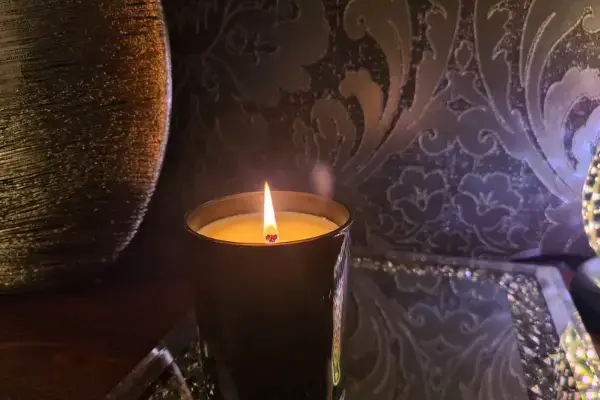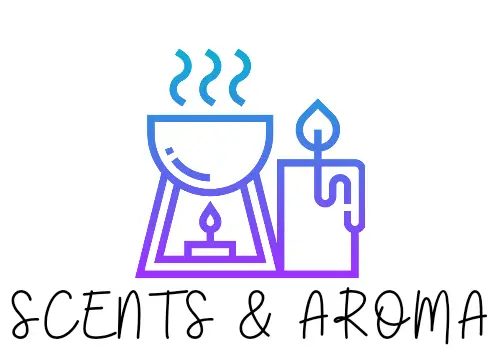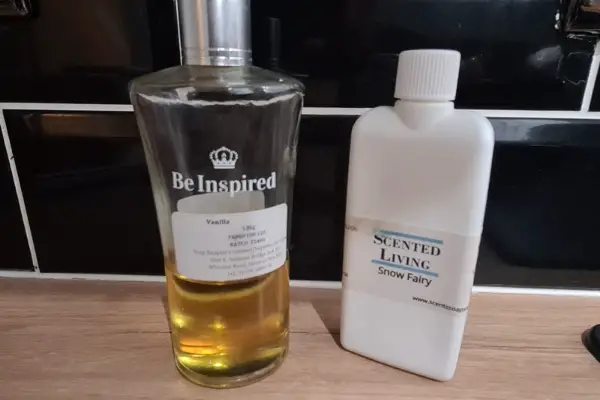Scent throw is an important factor when it comes to people buying scented candles and wax melts. If you watch people walk around candle stores, you’ll notice them raise candles to their noses. The truth is that scent sells. So with that in mind this article is going to be about which wax is the best for scent throw.
I will also cover some other factors that make huge differences to possible scent throw of the wax.
So, what is the best candle wax for scent throw? If your main priority when burning a candle is having the maximum scent throw, both hot and cold, then paraffin wax is the best wax to choose. It holds much more fragrance and releases the vapour much more uniformly.
That said, there are many reasons why you might choose another wax over paraffin despite its good scent throw. Let’s look in more detail.
Hot vs cold scent throw- what is the difference?
There are actually two types of scent throw: hot throw and cold throw.
The cold throw is the scent released at room temperature. In other words, when the candle is not lit. The hot throw is the scent that comes off the candle when it is burning.
Candlemakers can’t just consider their cold scent throw. Although this is important for enticing customers, it isn’t enough to keep them returning if the candle’s hot throw is bland! Repeat custom comes from the hot scent throw.
How do waxes and fragrances work together?
The number of wax choices is great nowadays, and the type of wax used can really have an impact on the candle’s scent throw. Waxes and fragrances work together in a balance. Some waxes will release lots of scent, while others don’t (but they perhaps have other benefits).
Fragrance oils don’t work the same with all waxes. No matter how hard you try, there are some fragrance oils that just won’t blend well with certain waxes. Soy wax, in particular, is more difficult to pair with fragrance oils that work. Generally speaking, however, paraffin waxes will provide a stronger scent throw compared to soy waxes.
To achieve the perfect scent throw you must make sure to use the correct amount of fragrance oil to wax. To achieve this use my handy fragrance oil calculator.
Candles and wax melts are generally scented in two ways, either fragrance oils or essential oils. For more information on the differences check out my article.
Paraffin Vs Soy scent throw
A lot of people ask about scent throw between soy and paraffin waxes. Many think that if wax can hold more fragrance oil, then its scent throw will be stronger. However, this is not entirely true because the wax type readily affects the candle’s scent throw.
When comparing a paraffin candle’s scent throw to a soy candle’s, you’ll probably notice that the paraffin one has a stronger scent throw. This is because paraffin wax is less dense than soy wax on a molecular level. Also, because soy wax burns more slowly, it takes longer for it to release its fragrance. On the other hand, paraffin burns much more easily and so releases the fragrance better and more strongly.
For more information about the different types of waxes used in candle making have a look at my helpful guide.
Other things that affect a candle’s scent throw
We can’t just write about the type of wax used without discussing the other aspects of a candle that affect its scent throw. Other factors include the brand of fragrance oil used, the fragrance’s notes, how much fragrance oil is used, the temperature of the wax when the fragrance oil was added to it, any additives in the wax, the wick, and the curing time.
Fragrance oil brand
Some fragrance oil manufacturers use lower solvent amounts and more natural ingredients in their fragrance oils. This tones down the strength of the fragrance.
Fragrance notes
Some fragrance oils are not designed to be overpowering. Rather, they’re meant to have a subtle, softer scent.
Quantity of fragrance oil added to the wax
You won’t get a very good scent throw if you use too little fragrance oil. Optimal scent throw is usually one oz. of fragrance oil per pound of wax. Lower strength fragrance oils might need to be added in double the quantity.
Adding too much fragrance oil isn’t necessarily the way to get a stronger scent throw. Using too much can impair the candle’s ability to burn well.
The wax’s temperature when the fragrance is added
If the temperature of the wax is too high when the fragrance oil is added, it might burn off or dissipate into the wax. Conversely, if the temperature is too low, the fragrance oil might not bind uniformly and might not disperse properly into the molten wax.
Fragrance oil should be added when the temperature of the wax is around 180° to 185° F.
Wax additives
Adding substances like vybar means the wax can handle higher loads of fragrance oil. With pure paraffin wax, additives mean the wax can hold more fragrance oil.
Aspects of the candle wick
Having the right size wick means that there will be a proper burn pool to aid the candle’s scent throw. If the wick is too small, the burn pool will be small, and thus, the scent throw will be poor. If the wick is too large, the wick might burn at too high a temperature, meaning that the fragrance will burn off and not throw its scent.
For the best scent throw, the wick should burn steadily to produce a burn pool that is between 1/4″ and 1/2″ deep.
One of the most popular types of wick when you buy candles these days tends to be a wooden wick, if you would like to know the benefits of wood wicks I have a complete guide to this.
Wax curing time
Wax candles need to be cured before being lit otherwise, the scent throw might not be perfect. Paraffin wax candles only need up to 48 hours to cure, while soy wax candles take between one and two weeks.
Curing simply means solidifying entirely. So while the candle may look solid quickly, it will remain soft in its interior for much longer. And since soy wax has a lower melting point, it takes a longer time to cure completely.
What other considerations are there?
While paraffin wax might be the best choice for scent throw, many candle makers and consumers are becoming more conscious of the negatives that come with paraffin wax.
For example, paraffin is derived from petroleum and is, therefore, a fossil fuel and a non-renewable product. On the other hand, Soy wax is entirely plant-based and sustainable (although the soy market is not without controversy either).
So, the environmentally friendly among us might be willing to swap a stronger scent throw for a more eco-friendly product.
Secondly, paraffin wax contains many toxins and carcinogens that are released into the air when the candle burns. As a result, more and more consumers are looking for natural wax scented candles for a safer burning experience.
This means that they might be willing to compromise on the stronger scent throw to breathe safer air.
Final thoughts and conclusion – which is the best candle wax for scent throw?
It’s cold throw that might sell candles, but it is hot throw that will keep customers coming back. This means that both hot throw and cold throw are important.
In terms of waxes, then, paraffin wax is the best for its scent throw. However, there are many reasons why you might want to avoid paraffin wax candles and opt for the less strong scent throw of a soy wax candle.
The eco-friendly and health-conscious among us might actually prefer to choose a more natural wax with a weaker scent throw if it means that no harm comes to them or the environment in the candle’s production and burning.
Ultimately, burning a scented candle is a delicate balance between the temperature of the flame, the temperature of the melt pool, the fragrance dispersion in the candle, the type of wax used, and the wick used.
- Can You Put Perfume In A Humidifier? (Read First) - September 17, 2022
- Can You Put Essential Oil In A Steam Mop? (Safety Advice) - September 17, 2022
- How To Make Lavender Oil At Home ( Candles And Diffusers) - September 9, 2022

